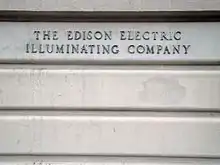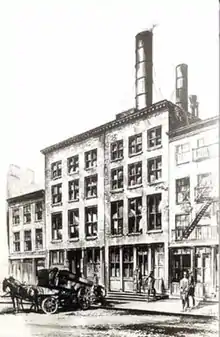Edison Illuminating Company
The Edison Illuminating Company was established by Thomas Edison on December 17, 1880, to construct electrical generating stations, initially in New York City. The company was the prototype for other local illuminating companies that were established in the United States during the 1880s.[1]
 The Edison Illuminating Company sign on Beacon Street in Boston, Massachusetts | |
| Industry | Electricity |
|---|---|
| Fate | Purchased by Consolidated Gas |
| Successor | Consolidated Edison |
| Founded | December 17, 1880 in New York City, United States |
| Founder | Thomas Edison |
| Defunct | 1901 |
Key people | Henry Ford (chief engineer) James Hood Wright (board member) |
History
Pearl Street Station

On September 4, 1882, Edison's first central station, the Pearl Street Station, opened at 257 Pearl Street in Manhattan. The station was the first commercial power plant in the United States, and was the world's first cogeneration plant. The plant burned down on January 2 1890. Only 1 dynamo (or generator) survived, and is currently displayed at the Henry Ford Museum.[2] The Institute of Electrical and Electronics Engineers designated it as a milestone in 2011.[3]
Other stations
In November 1882, the Edison Electric Illuminating Company of Shamokin, Pennsylvania was established. In 1883, it became only the second three-wire electrical station in the world.[4] The first was Edison's plant in Sunbury, Pennsylvania, which opened on July 4, 1883. The opening ceremony was attended by Edison himself. Even today, Edison's presence is remembered throughout the town, with the Edison Hotel[5] and a monument just outside Sunbury. On October 1, 1883, the Brockton Edison Electric Illuminating Company Power Station, another three-wire plant, opened in Brockton, Massachusetts and was capable of supplying about 1600 lamps.[6] The Brockton station is listed in the National Register of Historic Places.[7] On November 17, 1883, the Edison Electric Illuminating Company of Mount Carmel, Pennsylvania was founded. This was the first isolated electrical plant in the world, meaning that the entirety of Mount Carmel was powered by electricity. 38 arc lamps and 50 incandescent light bulbs were erected in the downtown business district.[8] Edison also opened plants in Fall River, Massachusetts (1883),[9] Cumberland, Maryland (1884), Tamaqua, Pennsylvania (1885),[10] and Boston (1886).[11]
Fate
The Edison Illuminating Company was purchased by Consolidated Gas in 1901. In 1936, with electricity sales far outpacing gas sales, the company changed its name to Consolidated Edison. Today, Con Ed is a multi-billion dollar company that provides power to around 3.3 million people.[12]
Notable employees
In 1891, Henry Ford became an engineer with the Edison Illuminating Company, and was promoted to Chief Engineer in 1893. He left the company on August 15, 1899 to focus on automobile manufacturing.[13] James Hood Wright was a board member of the company.[14]
References
- "Edison's Companies". edison.rutgers.edu. Retrieved 23 April 2019.
- "Pearl Street Station". ethw.org. Retrieved 23 April 2019.
- "Milestones:Pearl Street Station, 1882". ethw.org. Retrieved 23 April 2019.
- "Shamokin and Coal Township History". shamokincity.org. Retrieved 23 April 2019.
- "The Hotel Edison". Retrieved 23 April 2019.
- Electrical World. McGraw-Hill. 1922. Retrieved 23 April 2019.
- "Brockton Edison Electric Illuminating Company Power Station". npgallery.nps.gov. Retrieved 23 April 2019.
- Cassel, Alva C. "The Mount Carmel Story". bfchistory.org. Retrieved 23 April 2019.
- Moniz, William A. (Jan 8, 2015). "Thomas Edison's visits to Fall River key in establishing one of nation's earliest electric companies". South Coast Today. Retrieved 24 April 2019.
- "A Look at Tamaqua's Geography". rfohl.com. Retrieved 24 April 2019.
- "Boston Edison Company History". fundinguniverse.com. Retrieved 24 April 2019.
- "Our Businesses". conedison.com. Retrieved 23 April 2019.
- "Henry Ford leaves Edison to start automobile company". HISTORY. A&E Television Networks. Retrieved 23 April 2019.
- Railway World 1894, p. 910.
Sources
- Railway World (1894). Railway World.